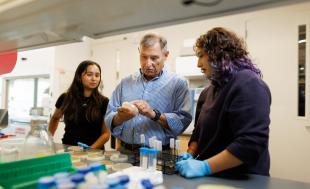Students Design Web App with DX Hub and SLO County to Prevent Opioid Overdose Deaths

In an effort to reduce the number of opioid-related deaths in San Luis Obispo County, local health officials, in collaboration with the Cal Poly Digital Transformation Hub (DxHub), powered by Amazon Web Services (AWS), and a team of university students are releasing a new app that could save lives.
Using the Naloxone Now app, community members can find the nearest location to get naloxone — an opioid overdose reversal medicine — or have naloxone delivered to their door at no cost.
The County of San Luis Obispo Behavioral Health Department launched the web application today which provides life-saving resources on how to prevent an overdose from opioid (painkiller medication and heroin) misuse.

It was designed with help from the DxHub and a team of Cal Poly students using AWS Cloud-based tools and Amazon’s Working Backwards innovation methodology.
The SLO County Behavioral Health Department and the SLO Opioid Safety Coalition, which was created in 2016 to address the local impacts of the opioid epidemic, brought the challenge to the DxHub as a way to fight the opioid epidemic locally.
Opioid misuse is a national epidemic. In recent years, death rates from these drugs, including both prescription and illicit drugs, have skyrocketed across the country to upwards of 75,000 a year, or 207 a day, according to Centers for Disease Control provisional data.
Opioid abuse is a complex problem. It impacts a broad spectrum of society and cuts across income and age groups, making prevention measures hard to target and address. California experienced 5,502 opioid-related deaths in 2020.
During the COVID-19 pandemic, fatal opioid overdoses increased by over 30% nationally, with every state experiencing an increase. In San Luis Obispo County, the death toll more than doubled from 21 in 2019 to 55 in 2020. According to the American Medical Association, the spike in deaths was likely due to the increased presence of fentanyl in illicit substances. Fentanyl is a powerful synthetic opioid that is similar to morphine but is 50 to 100 times more potent.
To help save lives, naloxone can be used when an individual overdoses on opioids. It attaches to opioid receptors in the brain and reverses and blocks the effects of other opioids. Naloxone can quickly restore normal breathing to a person if their breathing has slowed or stopped because of an opioid overdose.
The web app provides people with access to opioid overdose response training and a complimentary naloxone kit, confidentially delivered to their homes. This empowers people to be ready, able and equipped to respond to an overdose event enabling them to save a life.
The app is the result of a collaboration between the DxHub and the SLO Opioid Safety Coalition, composed of social service providers, law enforcement, physicians, substance use disorder treatment professionals, harm reduction organizations, County of San Luis Obispo Public Health and Behavioral Health department officials, educators and other community members, including Cal Poly Professor Candace Winstead of the Biological Sciences Department, working to address the local opioid epidemic.
“Thanks to the DxHub, our community members will be able to access naloxone and learn how to administer it without fear of stigma or judgment,” said Jenn Rhoads, coordinator of the SLO Opioid Safety Coalition. “We’ll be able to get naloxone in the hands of anyone who needs it, whether they are struggling with addiction themselves or trying to protect a friend, family member or neighbor.”
The cross-discipline student team worked with DxHub staff to research and understand the problem and needs of the coalition and collaborated with AWS Cloud Practitioner Certified staff to design the solution. The students included: Natali Markowitz of Boca Raton, Florida (M.S., Engineering Management, ’21; Industrial Engineering, ’21); Chloe Heinz of San Diego (Graphic Communication, ’21); Danielle Knell of San Jose, California (Business Administration, Information Systems Area, ’20); and Reilly Salkowski, a software engineering senior from Tucson, Arizona.
“The mission of the DxHub is to use software to help make an impact on the community,” Salkowski said. “With open-source solutions like this, developers can build on each other’s technology to make the world a better place.”
According to Paul Jurasin, director of the DxHub, the students are the driving force behind the DxHub’s success.
“The students keep the inspiration alive,” he said. “You see the lightbulb go on, and you know something amazing is coming.”
The Naloxone Now app can be found at http://naloxonenowslo.org/.
Don't want to miss any of the best Cal Poly News stories? Sign up for our monthly newsletter, the Cal Poly News Recap!




